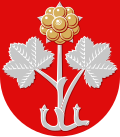Rubus chamaemorus
Rubus chamaemorus is a rhizomatous herb native to cool temperate regions, alpine environments, and the arctic tundra. Also known as the cloudberry, bakeapple (in Atlantic Canada), knotberry (in England), and akebia (in Japan), it is an important cultural symbol and economic product in several countries.
Description[edit]
The Rubus chamaemorus plant is a low-growing perennial with a creeping habit. Its leaves are alternate, palmately lobed, and white-felted underneath. The flowers are solitary, white, and produce a composite fruit that resembles a large raspberry. The fruit is initially pale red, ripening into an amber color in early autumn.
Habitat and Distribution[edit]
Rubus chamaemorus grows naturally throughout the Northern Hemisphere. It is found in Scandinavia, northern Russia, Canada, Alaska, and northern England. The plant prefers acidic, boggy soils in a range of habitats from mountainous regions to coastal dunes.
Uses[edit]
The fruits of Rubus chamaemorus are a valuable wild harvest in northern Scandinavia, particularly in Norway, Sweden, and Finland. They are used in traditional Nordic cuisine in jams, juices, tarts, and liqueurs. The fruit is rich in vitamin C and has potential health benefits.
Cultivation[edit]
Cultivation of Rubus chamaemorus is challenging due to its specific soil and climate requirements. However, it has been successfully grown in northern Europe and Canada, with some commercial cultivation for fruit production.
Conservation[edit]
In some areas, Rubus chamaemorus is a threatened species due to habitat loss from industrial development and climate change. Conservation efforts are ongoing to protect and restore its populations.
See also[edit]
![]()
This flora-related article is a stub. You can help WikiMD by expanding it.
Rubus chamaemorus[edit]
-
Rubus chamaemorus, from Tromsø, August 2020
-
Rubus chamaemorus in the USA
-
Homemade cloudberry jam
-
Leipäjuusto cheese with cloudberry jam
-
Muurame coat of arms
Ad. Transform your life with W8MD's Budget GLP-1 injections from $75


W8MD offers a medical weight loss program to lose weight in Philadelphia. Our physician-supervised medical weight loss provides:
- Weight loss injections in NYC (generic and brand names):
- Zepbound / Mounjaro, Wegovy / Ozempic, Saxenda
- Most insurances accepted or discounted self-pay rates. We will obtain insurance prior authorizations if needed.
- Generic GLP1 weight loss injections from $75 for the starting dose.
- Also offer prescription weight loss medications including Phentermine, Qsymia, Diethylpropion, Contrave etc.
NYC weight loss doctor appointmentsNYC weight loss doctor appointments
Start your NYC weight loss journey today at our NYC medical weight loss and Philadelphia medical weight loss clinics.
- Call 718-946-5500 to lose weight in NYC or for medical weight loss in Philadelphia 215-676-2334.
- Tags:NYC medical weight loss, Philadelphia lose weight Zepbound NYC, Budget GLP1 weight loss injections, Wegovy Philadelphia, Wegovy NYC, Philadelphia medical weight loss, Brookly weight loss and Wegovy NYC
|
WikiMD's Wellness Encyclopedia |
| Let Food Be Thy Medicine Medicine Thy Food - Hippocrates |
Medical Disclaimer: WikiMD is not a substitute for professional medical advice. The information on WikiMD is provided as an information resource only, may be incorrect, outdated or misleading, and is not to be used or relied on for any diagnostic or treatment purposes. Please consult your health care provider before making any healthcare decisions or for guidance about a specific medical condition. WikiMD expressly disclaims responsibility, and shall have no liability, for any damages, loss, injury, or liability whatsoever suffered as a result of your reliance on the information contained in this site. By visiting this site you agree to the foregoing terms and conditions, which may from time to time be changed or supplemented by WikiMD. If you do not agree to the foregoing terms and conditions, you should not enter or use this site. See full disclaimer.
Credits:Most images are courtesy of Wikimedia commons, and templates, categories Wikipedia, licensed under CC BY SA or similar.
Translate this page: - East Asian
中文,
日本,
한국어,
South Asian
हिन्दी,
தமிழ்,
తెలుగు,
Urdu,
ಕನ್ನಡ,
Southeast Asian
Indonesian,
Vietnamese,
Thai,
မြန်မာဘာသာ,
বাংলা
European
español,
Deutsch,
français,
Greek,
português do Brasil,
polski,
română,
русский,
Nederlands,
norsk,
svenska,
suomi,
Italian
Middle Eastern & African
عربى,
Turkish,
Persian,
Hebrew,
Afrikaans,
isiZulu,
Kiswahili,
Other
Bulgarian,
Hungarian,
Czech,
Swedish,
മലയാളം,
मराठी,
ਪੰਜਾਬੀ,
ગુજરાતી,
Portuguese,
Ukrainian




